Pigface is the Common name for a group of succulent plants, the Mesembryanthemum and Lampranthus which are both native to Africa, and the Australian Native Pigface, Carpobrotus. All of these species of Pigface share similar characteristics... they are low-growing groundcover plants with green to grey succulent leaves. The leaves are fleshy and full of water, which means the plant will tolerate ( and prefers ) a well, drained soil and dry, hot conditions where it puts on a fabulous display of flowers in Spring and Summer. Pigface flowers come in almost any colour, and are similar to daisy flowers, although they only open up fully on days where they get full sun, not on cloudy or overcast days.
Pigface are a great plant for rockeries, and garden borders where they are planted in front of taller growing shrubs, or they are also good for pots. The trailing growth habit means they spill over rock walls, and this makes them ideal for hanging baskets too. You will find them very easy to grow, and will cover an area quite quickly. Sandy, well drained soil is preferable, as the plants don't like to have wet roots. I took these photos in local Sydney gardens.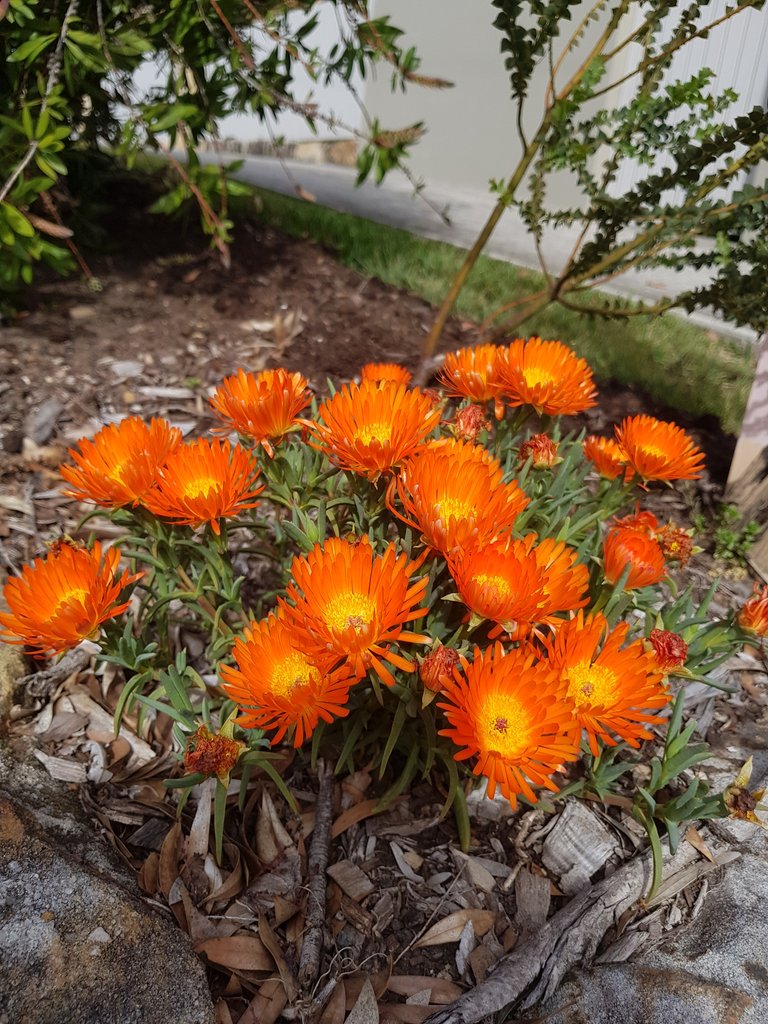
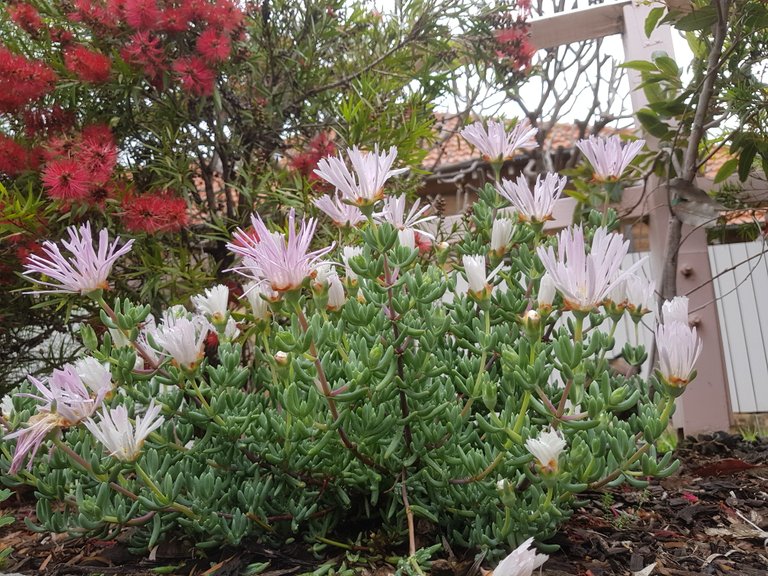
This ground-hugging plant with its fleshy, drought-resistant leaves is at its most spectacular when it opens its bright pink flowers. Flowering happens at any time of year, depending on location. An introduced pigface species, Carpobrotus edulis, has yellow flowers.
Pigface is a valuable food plant. Its scientific name is derived from Greek words meaning ‘edible fruit’ – a fact well-known by Tasmanian Aborigines. For a guaranteed food source in dry, lean times they would camp close to the plant they knew as wend-dar.
Most valued was the sweet red tasty fruit, with a flavour compared to strawberries, figs, kiwi fruit and raspberries. The fleshy leaves were also eaten cooked, and the juice from the leaves was used to soothe blisters, burns and pain from insect bites.
source
Fav. comment Award ! Great comment with nice Pics and information.
@ctrl-alt-nwo,
Wow it's beautiful! I see different colors of this flower in my country also! You could made a stunning photography of these flowers and personally I like that photography #1!
Cheers~
Wow look on this wonderful color that make it look such a live
Carpobrotus is a water-retaining plant, widespread in coastal areas of Southern Australia and in many parts of the world. Well exposed to coastal locations, this plant is a genus of about 25 species. Its beautiful daisy-like purple flowers are common to sand-dunes and are winter to spring flowering. Some of the species have some peculiar names; you might need a vivid imagination in order to see a connection between the plant’s flower and its common name.
Carpobrotus rossii is a prostrate plant, which has a beautiful purple colored flower with a white center. Amazingly they are known as the Pig Face plant, though you may not find any resemblance between the flower and a pig’s face. It is a salt-resistance plant and can be found year round in coastal areas. In Australia, people used to eat its fruit. Juice from its leaves was used to relieve burns and pains.
This plant is known as the Hottentot Fig, Highway Ice-plant, Sour fig or sometimes the Ice-Plant. It is a beautiful plant native to South Africa, which has yellow, pink or orange flowers and fleshy fig like fruit. Carpobrotus edulis, is a fast-spreading plant with bright flowers. Not only its fruits are edible, but the leaves too, which taste like a pickled cucumber. It flowers from June to August, and is able to inhabit rocky places.
Source: http://scribol.com/environment/plants/the-bizarrely-named-pigface-flower/
Carpobrotus, commonly known as Pigface, Ice Plant, and Hottentot Plant, is a genus of ground-creeping plants with succulent leaves and large daisy-like flowers. The name refers to the edible fruits. It comes from the Ancient Greek karpos (“fruit”) and brota (“edible”).
The genus includes about 20 accepted species. Most are South African, endemics, but there are at least four Australian species and one South American.
Various Carpobrotus species are invasive introduced species in suitable climates throughout the world. The harm they do is variable, and sometimes hotly debated, when balanced against their value as firebreaks and as food for wildlife.
https://worldofsucculents.com/how-to-grow-and-care-for-carpobrotus/
Thanks again for sharing some great photos.
It's always a pleasure to share your Blog on twitter for my followers to see and promoting #Steemit at the same time.
Have a great weekend.
Stephen
#Promo-Steem #steemtalent #JoinSteemit #Steemit
Pigface - beautiful plant, unfortunate name. #STEEM #steemtalent #JoinSteemit #Steemit
#garden #gardening #gardensworld #plant #life #blog #blogger #australia #photography #photographer
Carpobrotus edulis is an easy to grow, water wise succulent with large 3-angled leaves and edible fruits. It forms dense mats and is frequently used for stabilizing sandy areas, dunes and embankments. It is fire-resistant and can be planted around a property in fire-prone areas. Once established, this plant is truly water wise and requires little attention. Because this plant is often undisturbed for long periods of time, it creates a sanctuary for a variety of small creatures including reptiles, rodents and a range of bugs and beetles.
Carpobrotus edulis thrives on neglect. It needs well-drained soil, a sunny position and room to spread. It is an excellent evergreen drought and wind resistant groundcover that thrives happily on flat, sandy ground and loose sand dunes, in stony soil and lime-rich or brackish soils. When planted as a groundcover around the house, this juicy vygie creates a fire-resistant barrier. Avoid use of fetilisers and compost.
http://pza.sanbi.org/carpobrotus-edulis
Beautiful plant, my friend and Carpobrotus glaucescens is a prostrate, creeping succulent that has long trailing stems to 2 m long, which root at nodes along the stems. From these nodes the plant produces upright leafy branches. It has thick, fleshy, smooth leaves 3.5-10 cm x 1-1.5 cm, which are triangular in cross section. The plant grows to form a groundcover that can cover a large area.
The plant produces large, striking, deep pink-purple daisy-like flowers from October to January, but also can flower sporadically throughout the year. The plant produces a red-purple berry fruit, which was used by the native aborigines as a food source. The flesh of the fruit is said to have a taste similar to salty apples. The roasted leaves have been used as a salt substitute. Early European explorers used the plant as an anti-scurvy treatment. The juice of the leaves can also be used to relieve pain from insect bites.
Carpobrotus glaucescens is found growing naturally in coastal areas on sand dunes along the NSW and Queensland coast, north to Rockhampton. It also grows down into the east coast areas of Victoria. Pigface grows on the front of sand dunes and acts as a stabilizer where it helps to bind the sand, this allows more effective sand stabilizers such as spinifex grass to take a hold. Being a pioneer species it is important in paving the way for more complex communities.
As would be expected C. glaucescens is very salt tolerant and is able to withstand salt spray, strong winds and sand blast. If covered with sand the plant can survive, grow upwards and produce a new plant mat over the old one.
Pigface is generally a summer-spring growing plant. It can be grown either from seed or cuttings. Propagation is easiest by layering (rooting horizontal stem cuttings), as this is how the plant grows naturally. These layers should be around 30 cm in length and planted leaving at least 5 cm of the plant above the sand or soil. The plant can also be grown from cut pieces or division of large plants.
C. glaucescens will grow in most relatively well-drained positions in either full sun or partial shade; though an open sunny position is best. Pigface can also tolerate extended dry periods. Pigface is relatively pest free but may be attacked by scale insects in summer.
Carpobrotus glaucescens makes a colourful hardy and attractive groundcover suitable for the garden and is very useful for wind erosion control and for binding loose sandy soils. Over very large areas of sand dunes it is best planted in combination with Spinifex (Spinifex sericeus ) and Goats-foot (Ipomoea pes-caprae) as it seldom provides complete cover. Pigrace is definitely an attractive plant suitable for rockeries, low maintenance gardens or gardens with a sea side frontage.
Thank you @ctrl-alt-nwo
A source of information: https://www.anbg.gov.au/gnp/interns-2005/carpobrotus-glaucescens.html
Pigface was formed from Ministry's The Mind is a Terrible Thing to Taste tour, which produced the In Case You Didn't Feel Like Showing Up live album and video. For the tour, Al Jourgensen brought Atkins, Nivek Ogre and Chris Connelly. Also on the tour was Rieflin, regular Ministry drummer at the time. While Atkins enjoyed the dynamic of playing with a second drummer, he felt that the lineup was capable of doing much more than being, what he has frequently called, "a Ministry cover band." Once the tour was over, Atkins and Rieflin decided to continue working together and recruited several of their tourmates. Pigface was born with the intention of keeping a revolving-door style collaboration with many experimentally-minded musicians, many of whom, especially early on, had recorded for the influential industrial music record label Wax Trax!.

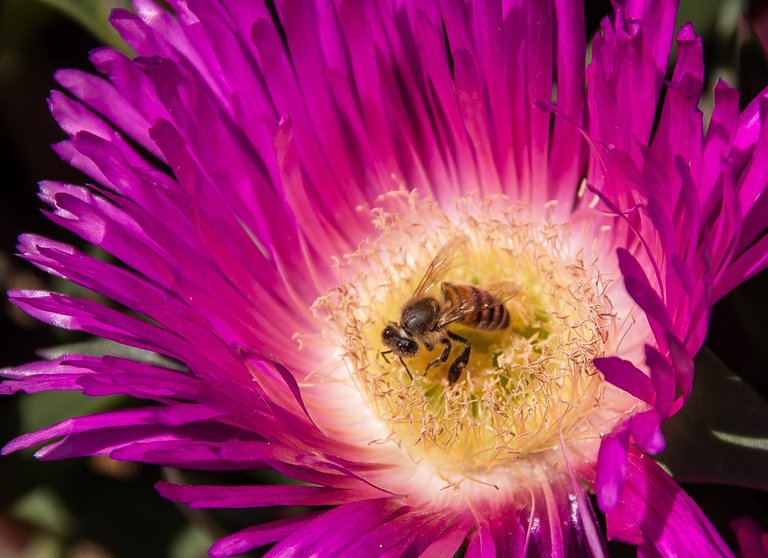

Source
Source
Source
Trent Reznor was also an early partner, before Nine Inch Nails became a household name. "Suck," co-written and sung by Reznor, was something of an underground hit, and Reznor later re-recorded the song for the Broken EP.
Source
Carpobrotus also known as Pigsface is a creeping succulent that forms a ground-cover. It has thick, fleshy green leaves with gorgeous pink/purple flowers. It is found on sand dunes along the east coast of Australia and acts as a dune stabilizer.
Chances are it was Carpobrotus glaucescens (also known as pigface, ice plant or angular sea fig). And you might be surprised to learn that not only is it native to Australia but it is also edible. The red-purple fruit has a flavour described by some as like salty strawberry or kiwi fruit and by others as like salty apples. Its thick, fleshy leaves can also be eaten – raw or cooked (the roasted leaves may be used as a salt substitute) and the juice from the leaves can be used to soothe stings or burnt skin. The juice from the leaves can be mixed with water and used as a gargle for sore throats and mild bacterial infections of the mouth. The fruit has also been used as a laxative.
Carpobrotus is a useful plant for gardeners wanting to avoid using chemical sprays because it is relatively pest free. But there is a chance it may be attacked by scale in summer in which case there are some environmentally-friendly ways to combat the pest: give them a blast with a high pressure hose in the morning three days in a row; wipe them off with a stick; dab with alcohol; or encourage predatory bugs.
References 12345
Speaking of beautiful plants, Pigface is the answer. However, talking about sources is rather confusing to get the right source, Sir. 😆
Why?
Because this Pigface plant has various names. In everyday life it is often called Iceplant. The scientific names are: Mesembryanthemum, Lampranthus, Carpobrotus, Dorothenanthus, and so on. And, it's very difficult to explain the similarities and differences of all.
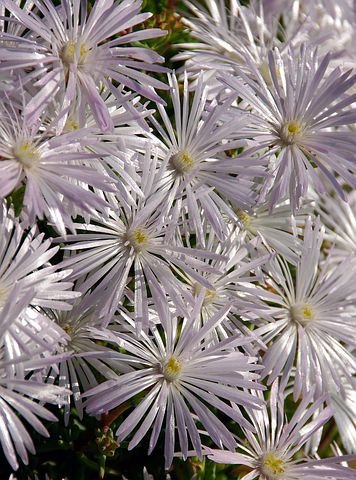
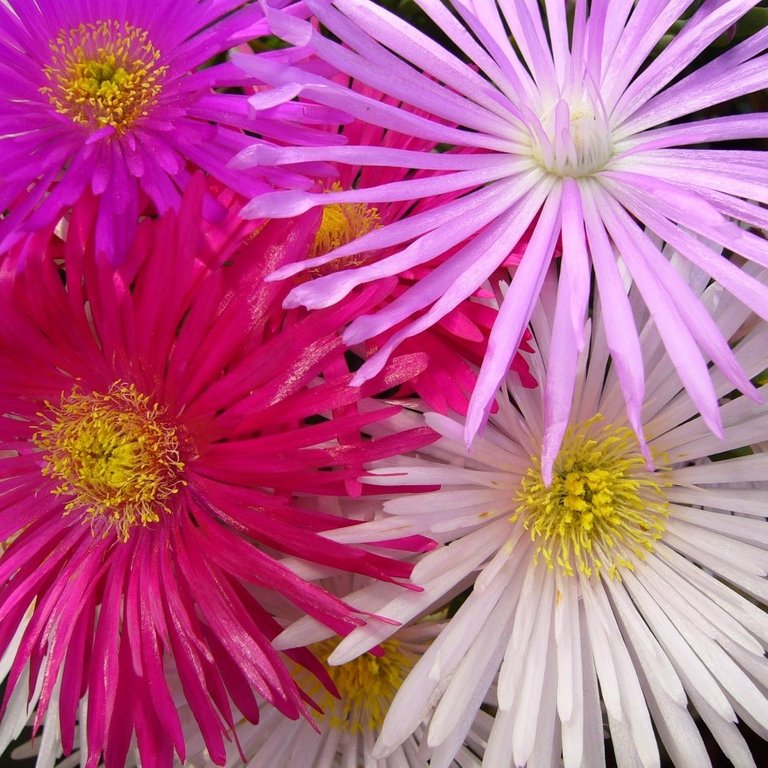
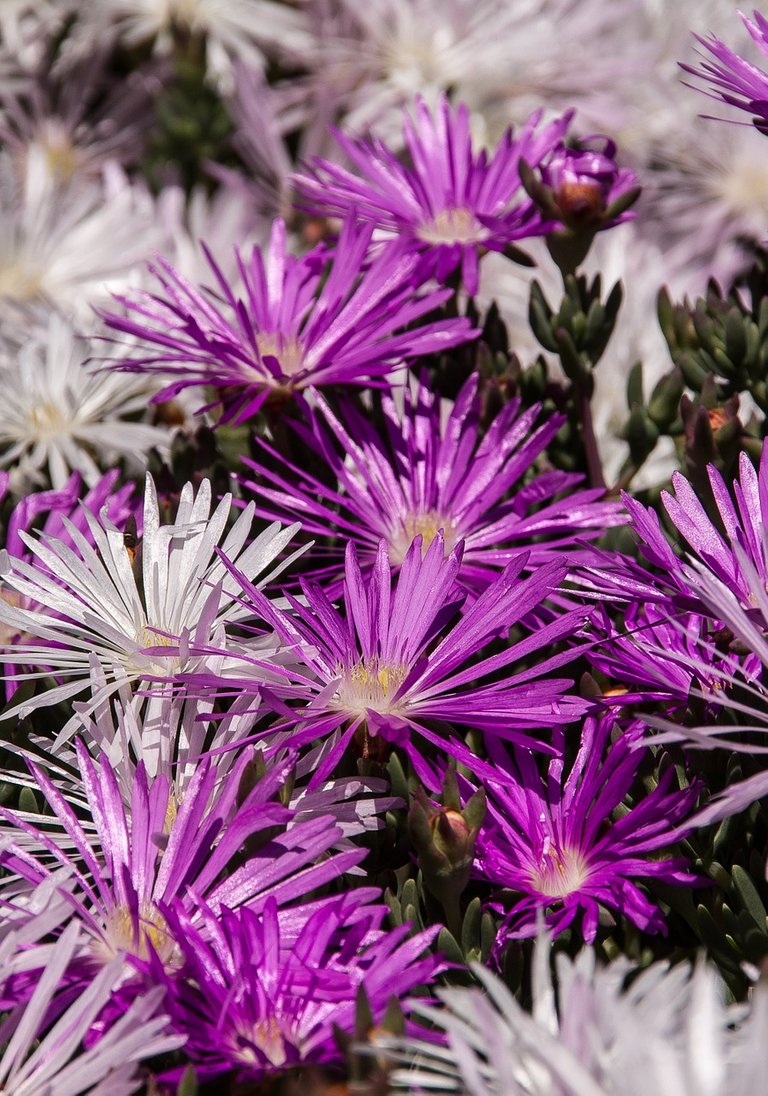
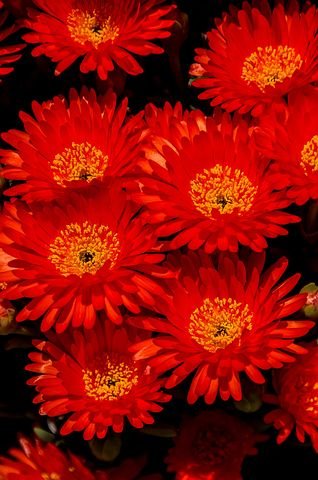
What I know, Pigface has delicious leaves and colorful flowers, there are red, pink, orange, white, purple and all of them offer very extraordinary views.
If observed in terms of growth, Pigface likes sandy space because Pigface has long, thick roots so that the coastline is a natural habitat suitable for this plant.
When flowering, Pigface can cover the entire plant so that the leaves and stems are not visible. The flowers are open when the sun is shining, so if it's raining or at night, the Pigface flower will be closed.
Regarding its natural habitat, Pigface originates from South Africa and the coast of South Australia called "Coastal Pigface" with species of Carpobrotus virescens, Carpobrotus rossii, etc.
Thank you!
Resources :
https://www.google.com/url?sa=t&source=web&rct=j&url=https://kiyanti2008.wordpress.com/tag/succulent/&ved=2ahUKEwi4wb7a3LXeAhUeSI8KHRAoAEUQFjATegQIBhAB&usg=AOvVaw2AbBBih-O3BmgiDAHDfNxp&cshid=1541162904972
If you’ve walked over a sand dune on the way for a swim on a summer’s day in Eastern Australia you may have noticed a succulent plant with a spectacular bright pink flower growing beside the path.Chances are it was Carpobrotus glaucescens (also known as pigface, ice plant or angular sea fig). And you might be surprised to learn that not only is it native to Australia but it is also edible. The red-purple fruit has a flavour described by some as like salty strawberry or kiwi fruit and by others as like salty apples.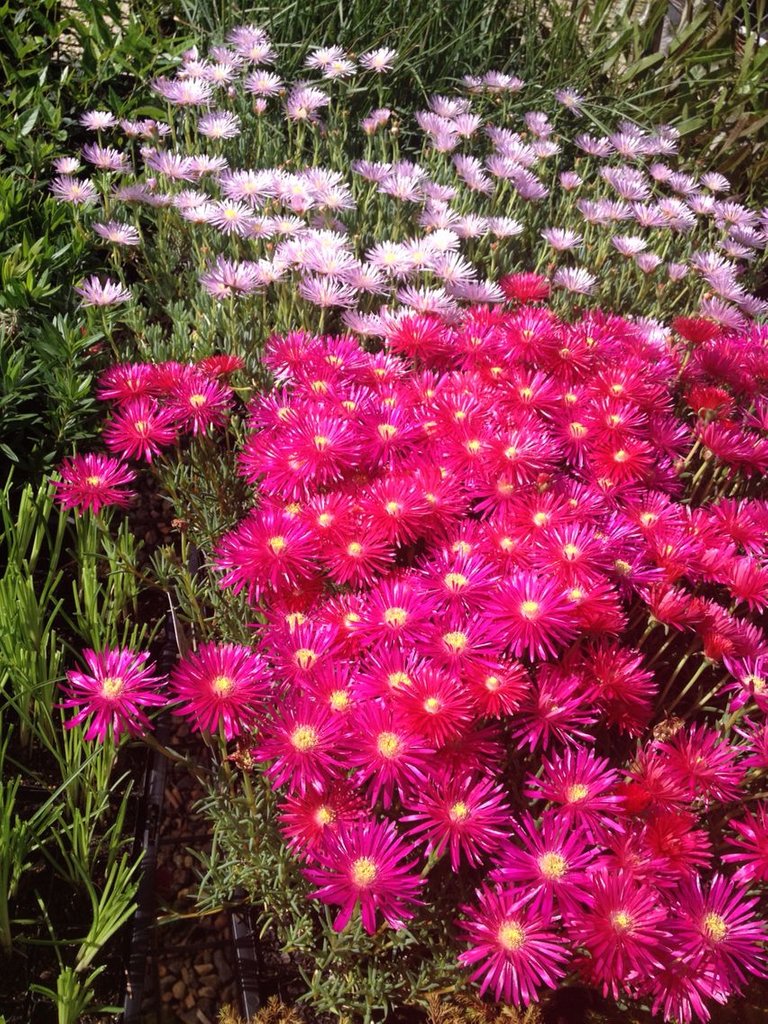
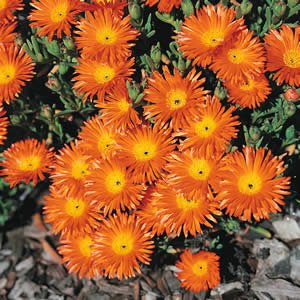
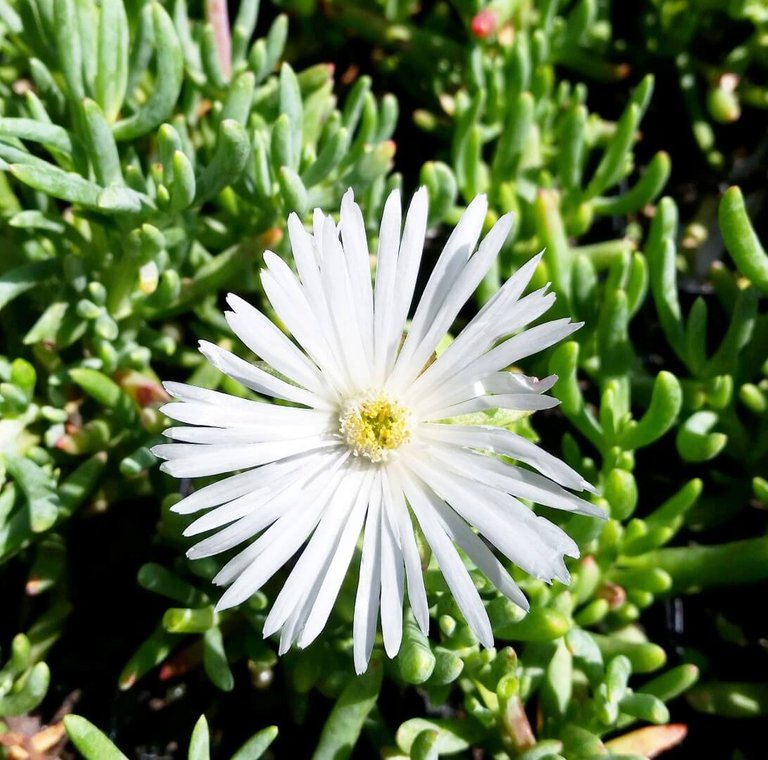
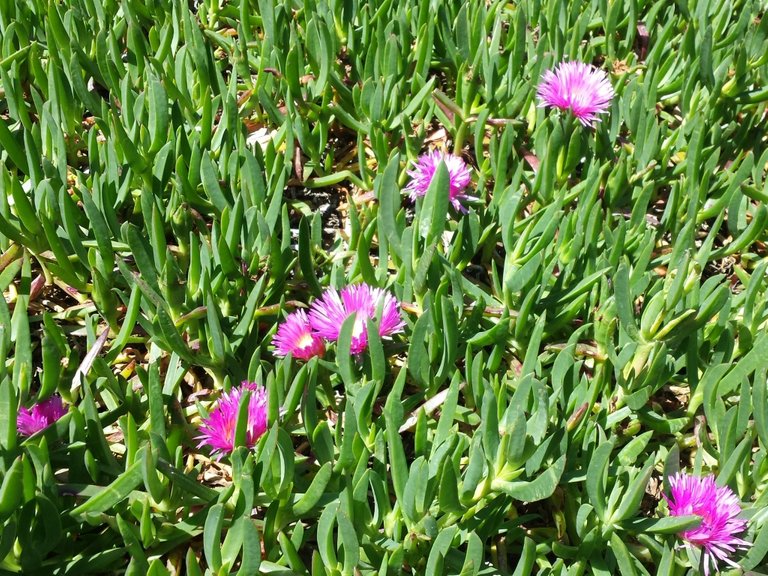 )
)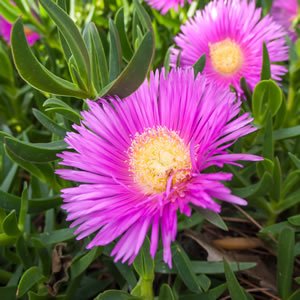
Its thick, fleshy leaves can also be eaten – raw or cooked (the roasted leaves may be used as a salt substitute) and the juice from the leaves can be used to soothe stings or burnt skin2. The juice from the leaves can be mixed with water and used as a gargle for sore throats and mild bacterial infections of the mouth. The fruit has also been used as a laxative.
The prostrate, creeping succulent is one of about 20 species of the genus Carpobrotus, most of which are native to South Africa. Six are indigenous to Australia and this includes C. glaucescens which grows naturally in coastal areas on sand dunes in NSW, Queensland and Victoria. You might get confused if you visit a garden centre looking for pigface as you will mostly find Mesembryanthemum, the genus in which Carpobrotus used to be included. There are 25 species of Mesembryanthemum mostly from Europe but also South Africa. Three species have naturalised in Australia. They are similar to Carpobrotus and are edible too.
![carpobrotus-rossii_native-pigface-1.jpg]
(
[Siurce]https://www.sgaonline.org.au/pigface-carpobrotus-glaucescens/
Carpobrotus virescens - Coastal Pigface
Carpobrotus belongs to Aizoaceae, a family that contains many succulent plants that grow in harsh, dry and exposed environments. Carpobrotus virescens is found on dunes and coastal limestone, often in the front line to take the full force of strong sandblasting winds and salt-spray. The strong winds blow the sand around to either expose or bury this plant, but it has evolved to exploit these conditions and seems to suffer no ill-effect.
Carpobrotus virescens is only found in Western Australia from the Nullarbor to Exmouth, but is relatively poorly collected with very scattered herbarium collections. This situation probably reflect its chunky succulent nature and the problems of pressing these specimens, or storing them in alcohol, but it is a very common and widespread coastal species and probably exists even further afield. In SA, Victoria and Tasmania, Carpobrotus rossii is a similar coastal species, which is also recorded from WA, but strangely only from the Peron Peninsula region, south of Carnarvon. In Victoria, NSW and Qld, there is Carpobrotus glaucescens another coastal species.
Very amazing endurance plants, beautiful is not capricious. thanks for the information
http://esperancewildflowers.blogspot.com/2011/12/carpobrotus-virescens-coastal-pigface.html
Carpobrotus glaucescens also known as Pigface or Angular Pigface is a member of the Family Aizoaceae. There are about 30 species in the genus, the majority being native to South Africa. There are 6 species native to Australia which are chiefly coastal in distribution with the exception of C. modestus which is an inland growing species.

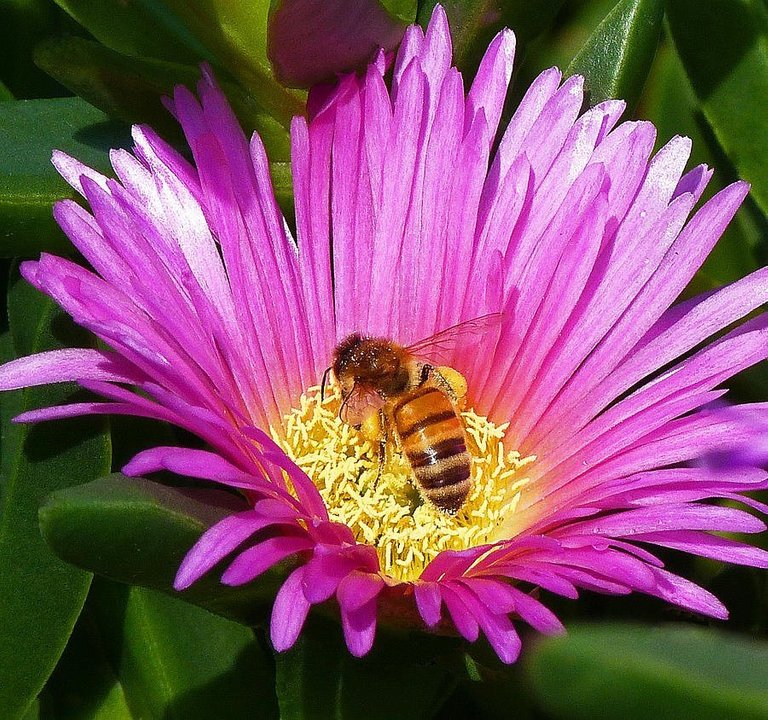
image source
The plant produces large, striking, deep pink-purple daisy-like flowers from October to January, but also can flower sporadically throughout the year. The plant produces a red-purple berry fruit, which was used by the native aborigines as a food source. The flesh of the fruit is said to have a taste similar to salty apples. The roasted leaves have been used as a salt substitute. Early European explorers used the plant as an anti-scurvy treatment. The juice of the leaves can also be used to relieve pain from insect bites.
image source
Carpobrotus glaucescens is found growing naturally in coastal areas on sand dunes along the NSW and Queensland coast, north to Rockhampton. It also grows down into the east coast areas of Victoria. Pigface grows on the front of sand dunes and acts as a stabilizer where it helps to bind the sand, this allows more effective sand stabilizers such as spinifex grass to take a hold. Being a pioneer species it is important in paving the way for more complex communities.
content source
It is one of the most beautiful flowers I had seen so far @ctrl-alt-nwo and it is funny to name it pigface too LOL. It seems that insects love it for its nectar and pollen, a good plant for our gardens.
The nana should be change to ‘pretty face!’ Poor flowers! What a sense of humour!
Posted using Partiko iOS
Pigface has a scientific name Carpobrotus glaucescens which belongs to the ice plant family, grouped under flowering plant category. The plant is a coastal ground cover one which originates from temperate eastern Australia. Leaves have 3.5-10 cm and 9-15 mm length and width, Flowers hold light purple color with width 3.2-6 cm, and Fruits with length and width of 2-3 cm and 1.6-2.4 cm possess a red to purple color. The pulp of the fruit is consumable having a flavor which is similar to that of a salty strawberry or kiwifruit. These wild fruits are considered the favorites of Australia for its well known taste, after the ripening they become purple and their pulp is eaten by squeezing it out.
source
So unfair name. I think miss Piggy would liked it ;)
what a great touch it has got beautiful to know about it beautiful at its best
@ctrl-alt-nwo, Yes, the Pig Face name is really weird for sure. But genuinely these flowers are really beautiful. But what i really liked about this plant is, it's really an ground level plant and due to these Breathtaking flowers for sure it's giving the add on beauty to the earth. And i believe that if anyone will walk beside of this plant then for sure they will going to explore it and will explore it's beauty. And good to see these flowers in Two different colours. Wishing you an great day and stay blessed. 🙂
Beautiful flowering ground cover. Wish I could grow these in my colder region. :-)
A robust, flat-growing, trailing perennial, rooting at nodes and forming dense mats. The succulent horizontal stems curve upwards at the growing point. The leaves are succulent, crowded along the stem, 60-130 x 10-12 mm, sharply 3-angled and triangular in cross-section, yellowish to grass-green, and reddish when older.
Flowers are solitary, 100-150 mm in diameter, yellow, fading to pale pink, produced mainly during late winter-spring (August-October). They open in the morning in bright sunlight, and close at night. Look into the centre of the flower and you'll see many stamens surrounding a beautiful starfish-like stigma. This species is easily
distinguished from the others as it is the only one with yellow flowers.
Fruit is fleshy, indehiscent and edible, 35 mm in diameter, shaped like a spinning top, on a winged stalk, becoming yellow and fragrant when ripe. The outer wall of the fruit becomes yellowish, wrinkled and leathery with age. The seeds are embedded in the sticky, sweet, jelly-like mucilage. The fruits can be eaten fresh and they have a strong, astringent, salty, sour taste. They are not as tasty as those of C. acinaciformis and C. deliciosus which are sweeter.
http://pza.sanbi.org/carpobrotus-edulis
Beautiful plants !!! Looks very beautiful. I did not think about how complicated they are, ordinary flowers.
Pigface has a scientific name Carpobrotus glaucescens which belongs to the ice plant family, grouped under flowering plant category. The plant is a coastal ground cover one which originates from temperate eastern Australia. Leaves have 3.5-10 cm and 9-15 mm length and width, Flowers hold light purple color with width 3.2-6 cm, and Fruits with length and width of 2-3 cm and 1.6-2.4 cm possess a red to purple color. The pulp of the fruit is consumable having a flavor which is similar to that of a salty strawberry or kiwifruit. These wild fruits are considered the favorites of Australia for its well known taste, after the ripening they become purple and their pulp is eaten by squeezing it out.
source
THE saying that everything old is new again could not be truer when referring to the colourful flowering ground cover called Pigface. This plant is widely regarded as having one of the most spectacular displays of bright flowers in the succulent world.Over the years gardeners have found Lampranthus relatively easy to grow in a sunny well-drained position. While these plants are frost tender many gardeners have successfully grown Lampranthus in a frosty areas if they are planted in a sheltered position. After the last few dry years many gardeners have started to look for plants that can withstand periods of drought. And Lampranthus is one of a few species that will withstand drought very well and do not require a lot of maintenance.
The vibrant flowers of the Lampranthus are in various colour shades of orange, pink, red, white, yellow as well some bicoloured varieties.
https://www.themorningbulletin.com.au/news/gardening-the-coveted-pigface-a-supreme-succulent/3108521/
I am very glad that I learned a lot of interesting and new things about this plant. thank
Carpobrotus, commonly known as pigface, ice plant, sour fig, and Hottentot fig, is a genus of ground-creeping plants with succulent leaves and large daisy-like flowers. The name refers to the edible fruits. It comes from the Ancient Greek karpos "fruit" and brotos "edible".

Carpobrotus chiefly inhabits sandy coastal habitats in mild Mediterranean climates, and can be also found inland in sandy to marshy places. In general, they prefer open sandy spaces where their wiry, long roots with shorter side branches form dense underground network, which extends much further than above-ground prostrate branches. Plants thrive well in gardens, but can easily escape to other suitable places. They easily form wide-area ground covers over a sandy soil, which easily suppresses indigenous sand dune vegetation when Carpobrotus is introduced to a non-native area.
Carpobrotus is native to South Africa, south Australian coast and coastal Chile. As an introduced species, it became widespread on similar habitats in the Northern Hemisphere: Pacific coast of the United States; Mediterranean and Atlantic coasts of Europe; and New Zealand.
Source
very nice flowers @ctrl-alt-nwo
Carpobrotus, commonly known as pigface, ice plant, sour fig, and Hottentot fig, is a genus of ground-creeping plants with succulent leaves and large daisy-like flowers. The name refers to the edible fruits. It comes from the Ancient Greek karpos "fruit" and brotos "edible".
The genus includes some 12 to 20 accepted species. Most are endemic to South Africa, but there are at least four Australian species and one South American.
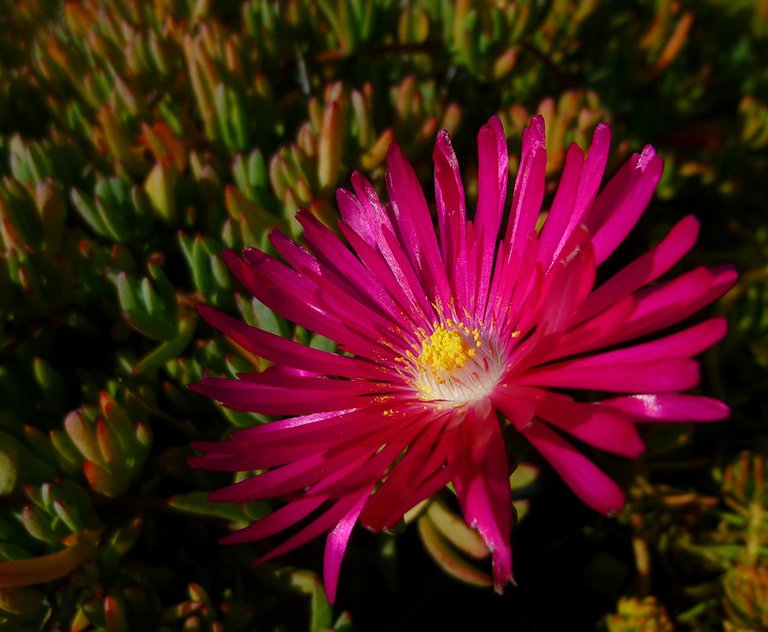
Contents
The fruit of various species of Carpobrotus is eaten by many animals and birds that also spread its seed.
Various Carpobrotus species are invasive introduced species in suitable climates throughout the world. The harm they do is variable, and sometimes hotly debated, when balanced against their value as firebreaks and as food for wildlife.Seeds are spread by mammals such as deer, rabbits, and rodents eating mature fruit
Carpobrotus acinaciformis and Carpobrotus edulis are often used for groundcover due to their rapid growth, dense habit, and resistance to fire. Carpobrotus are also drought tolerant.
These orange really are very beautiful! This is my favorite colors, my friend @ctrl-alt-nwo ! Enjoy with me the colors of my fall!

They growth too in my country colombia, they're a fount of meal for many insects as bees, you say they're very useful to decorate a house mostly for the infront so they catch all eyes and smell really good. Regards
Bees do an amazing work
magoo-2 found a series of multi accounts of a same owner is following your articles to cheat your generous rewards.
magoo-2 found these accounts are suspicious & can be multi accounts of a single owner. Conclusion is based on last 30 days transactions:
@martha75
@dim753
magoo-2
Check our latest multi comment spam update report
Again? i can't believe it, search more before say something or judge people, @martha75 is my mom look her blog oh i know you didn't read her blog, please do something different you have more than account and in your multiaccounts you do the same, i mean, i value a work like that but you have to do it excellent and you're no doing an excellent work, please read and read and search more info. Regards
very nice flowers @ctrl-alt-nwo
Carpobrotus, commonly known as pigface, ice plant, sour fig, and Hottentot fig, is a genus of ground-creeping plants with succulent leaves and large daisy-like flowers. The name refers to the edible fruits. It comes from the Ancient Greek karpos "fruit" and brotos "edible".
The genus includes some 12 to 20 accepted species. Most are endemic to South Africa, but there are at least four Australian species and one South American.
Contents
Various Carpobrotus species are invasive introduced species in suitable climates throughout the world. The harm they do is variable, and sometimes hotly debated, when balanced against their value as firebreaks and as food for wildlife.Seeds are spread by mammals such as deer, rabbits, and rodents eating mature fruit
Flowering and fruiting
The plant produces bright pink flowers in spring and summer. The fruit ripens when the flower is pollinated and spent. The fruiting body swells up and turns deep red, which makes it easy to spot among the green leaves. The fruit was used by native aborigines as a food source.
[source](https://www.sgaonline.org.au/pigface-carpobrotus-glaucescens/
magoo-2 found a series of multi accounts of a same owner is following your articles to cheat your generous rewards.
magoo-2 found these accounts are suspicious & can be multi accounts of a single owner. Conclusion is based on last 1 year transactions:
@faizazohaib
@faraz33
@zohaib336
@shoaib721
magoo-2
Check our latest multi comment spam update report
That flowers had a great colour and it's really cool for the eyes..
I just came to my girlfriends house and i took some of there flowers that i love..
I took it very close next time i would capture also the whole plants for other type of views..😊😊
arpobrotus glaucescens also known as Pigface or Angular Pigface is a member of the Family Aizoaceae. There are about 30 species in the genus, the majority being native to South Africa. There are 6 species native to Australia which are chiefly coastal in distribution with the exception of C. modestus which is an inland growing species.
Carpobrotus glaucescens distributionCarpobrotus glaucescens is a prostrate, creeping succulent that has long trailing stems to 2 m long, which root at nodes along the stems. From these nodes the plant produces upright leafy branches. It has thick, fleshy, smooth leaves 3.5-10 cm x 1-1.5 cm, which are triangular in cross section. The plant grows to form a groundcover that can cover a large area.
source
Pigface - Carpobrotus glaucescens
If you’ve walked over a sand dune on the way for a swim on a summer’s day in Eastern Australia you may have noticed a succulent plant with a spectacular bright pink flower growing beside the path.
Chances are it was Carpobrotus glaucescens (also known as pigface, ice plant or angular sea fig). And you might be surprised to learn that not only is it native to Australia but it is also edible. The red-purple fruit has a flavour described by some as like salty strawberry or kiwi fruit and by others as like salty apples1. Its thick, fleshy leaves can also be eaten – raw or cooked (the roasted leaves may be used as a salt substitute) and the juice from the leaves can be used to soothe stings or burnt skin2. The juice from the leaves can be mixed with water and used as a gargle for sore throats and mild bacterial infections of the mouth. The fruit has also been used as a laxative3.
The prostrate, creeping succulent is one of about 20 species of the genus Carpobrotus, most of which are native to South Africa. Six are indigenous to Australia and this includes C. glaucescens which grows naturally in coastal areas on sand dunes in NSW, Queensland and Victoria. You might get confused if you visit a garden centre looking for pigface as you will mostly find Mesembryanthemum, the genus in which Carpobrotus used to be included. There are 25 species of Mesembryanthemum mostly from Europe but also South Africa. Three species have naturalised in Australia. They are similar to Carpobrotus and are edible too.
Carpobrotus is a useful plant for gardeners wanting to avoid using chemical sprays because it is relatively pest free. But there is a chance it may be attacked by scale in summer in which case there are some environmentally-friendly ways to combat the pest: give them a blast with a high pressure hose in the morning three days in a row; wipe them off with a stick; dab with alcohol; or encourage predatory bugs.
Flowering and fruiting
The plant produces bright pink flowers in spring and summer. The fruit ripens when the flower is pollinated and spent. The fruiting body swells up and turns deep red, which makes it easy to spot among the green leaves. The fruit was used by native aborigines as a food source.
C. glaucescens is an important part of the ecosystem as it helps stabilise the sand dunes and attracts bees and other insects. Anyone foraging for pigface should avoid squashing it and make sure to leave some fruit for the birds and other creatures which help disperse the plant’s seed.
https://www.sgaonline.org.au/pigface-carpobrotus-glaucescens/
magoo-2 found a series of multi accounts of a same owner is following your articles to cheat your generous rewards.
magoo-2 found these accounts are suspicious & can be multi accounts of a single owner. Conclusion is based on last 1 year transactions:
@nanoz
@bingham
@ramela
@borna
@rabada2001
@mulder2000
@elva1999
@chrelye1989
magoo-2
Check our latest multi comment spam update report
Carpobrotus glaucescens, commonly known as angular sea-fig[1] or pigface, is a species of flowering plant in the ice plant family. It is a succulent coastal groundcover native to temperate eastern Australia.
The succulent leaves are 3.5–10 cm long and 9–15 mm wide, straight or slightly curved. The flowers are 3.2–6 cm wide, and light purple. The red to purple fruit is 2–3 cm long and 1.6–2.4 cm wide.
source
magoo-2 found a series of multi accounts of a same owner is following your articles to cheat your generous rewards.
magoo-2 found these accounts are suspicious & can be multi accounts of a single owner. Conclusion is based on last 1 year transactions:
@kheightces
@thytheso
@mabir
@ristotle
@tanuesh
@alizamanjutt454
@eastmund
@reicher
@vijayar
@lycusa
@snorio
@alexeyy
@surenda
@isuru1127
magoo-2
Check our latest multi comment spam update report
Pig Face is a fun, versatile plant with an unfortunate nick name.
Ground cover plants don’t come much tougher or lower maintenance than this. Native to Southern Africa, Pig Face is used to growing in dry, rocky and sandy conditions which makes it very tolerant to drought, salt and wind.
Its succulent foliage will form a dense and spreading mat, growing to no more than 15cm high and around 40cm wide. It’s prized of course for the spectacularly vibrant flowers that form all over the plant in early spring – electric shades of orange, pink, yellow and a crystal white that contrast beautifully with the foliage.
source
magoo-2 found a series of multi accounts of a same owner is following your articles to cheat your generous rewards.
magoo-2 found these accounts are suspicious & can be multi accounts of a single owner. Conclusion is based on last 30 days transactions:
@itamarr
@chocosteem
@berwyn
@benedetto
@bronter
@hungduan
magoo-2
Check our latest multi comment spam update report
This weed is a short-lived spreading perennial originally native to South Africa but now common in coastal bushland. Pigface was introduced as an ornamental plant, for erosion control, medicines and food. This weed should not be confused with the native species of Carpobrotus. Florabase has 5 native species, some of which are declared rare. If in doubt seek confirmation before removing any plants.
source
magoo-2 found a series of multi accounts of a same owner is following your articles to cheat your generous rewards.
magoo-2 found these accounts are suspicious & can be multi accounts of a single owner. Conclusion is based on last 30 days transactions:
@itamarr
@chocosteem
@berwyn
@benedetto
@bronter
@hungduan
magoo-2
Check our latest multi comment spam update report
Interesting Pigface Facts:
Pigface has trailing, fleshy stem that can reach 12 inches in height and 6.5 feet in length.
Pigface produces numerous shallow adventitious roots from the nodes on the stems.
Pigface has elongated, succulent leaves without petioles (they are directly attached to the stem). Leaves are smooth and triangular in shape. They can be dark or pale green colored (with a tinge of red color) and oppositely arranged on the stem.
Pigface produces large, daisy-like yellow or pink flowers. 120 to 130 petal-like structures are actually modified stamens (male reproductive organs). True petals are fleshy and fused at the base. They surround ovary.
source
magoo-2 found a series of multi accounts of a same owner is following your articles to cheat your generous rewards.
magoo-2 found these accounts are suspicious & can be multi accounts of a single owner. Conclusion is based on last 30 days transactions:
@itamarr
@chocosteem
@berwyn
@benedetto
@bronter
@hungduan
magoo-2
Check our latest multi comment spam update report
Carpobrotus is a water-retaining plant, widespread in coastal areas of Southern Australia and in many parts of the world. Well exposed to coastal locations, this plant is a genus of about 25 species. Its beautiful daisy-like purple flowers are common to sand-dunes and are winter to spring flowering. Some of the species have some peculiar names; you might need a vivid imagination in order to see a connection between the plant’s flower and its common name.
source
magoo-2 found a series of multi accounts of a same owner is following your articles to cheat your generous rewards.
magoo-2 found these accounts are suspicious & can be multi accounts of a single owner. Conclusion is based on last 30 days transactions:
@itamarr
@chocosteem
@berwyn
@benedetto
@bronter
@hungduan
magoo-2
Check our latest multi comment spam update report
Pigface (Carpobrotus glaucescens) is an amazingly common plant, often seen, but quite overlooked. It is so abundant around our coastal environments, so easy to grow at home and so useful. I love wild foraging for this plant along the beach, but I am also thinking of trying this plant as a ground cover in a food forest situation at home.
source
magoo-2 found a series of multi accounts of a same owner is following your articles to cheat your generous rewards.
magoo-2 found these accounts are suspicious & can be multi accounts of a single owner. Conclusion is based on last 30 days transactions:
@astique
@alinaloredana
@archista
magoo-2
Check our latest multi comment spam update report
Carpobrotus
Carpobrotus, commonly known as pigface, ice plant, sour fig, and Hottentot fig, is a genus of ground-creeping plants with succulent leaves and large daisy-like flowers. The name refers to the edible fruits. It comes from the Ancient Greek karpos "fruit" and brotos "edible".[1]
The genus includes some 12 to 20 accepted species. Most are endemic to South Africa, but there are at least four Australian species and one South American.
Distribution and habitat
Carpobrotus chiefly inhabits sandy coastal habitats in mild Mediterranean climates, and can be also found inland in sandy to marshy places. In general, they prefer open sandy spaces where their wiry, long roots with shorter side branches form dense underground network, which extends much further than above-ground prostrate branches. Plants thrive well in gardens, but can easily escape to other suitable places. They easily form wide-area ground covers over a sandy soil, which easily suppresses indigenous sand dune vegetation when Carpobrotus is introduced to a non-native area. [2]
Carpobrotus is native to South Africa, south Australian coast and coastal Chile.[2] As an introduced species, it became widespread on similar habitats in the Northern Hemisphere: Pacific coast of the United States; Mediterranean and Atlantic coasts of Europe; and New Zealand.[3]
https://en.wikipedia.org/wiki/Carpobrotus
magoo-2 found a series of multi accounts of a same owner is following your articles to cheat your generous rewards.
magoo-2 found these accounts are suspicious & can be multi accounts of a single owner. Conclusion is based on last 1 year transactions:
@sony1992
@melissa1999
@max1994
@tania12
@lararose
magoo-2
Check our latest multi comment spam update report
Carpobrotus, commonly known as Pigface, Ice Plant, and Hottentot Plant, is a genus of ground-creeping plants with succulent leaves and large daisy-like flowers. The name refers to the edible fruits. It comes from the Ancient Greek karpos (“fruit”) and brota (“edible”).
The genus includes about 20 accepted species. Most are South African, endemics, but there are at least four Australian species and one South American.
Various Carpobrotus species are invasive introduced species in suitable climates throughout the world. The harm they do is variable, and sometimes hotly debated, when balanced against their value as firebreaks and as food for wildlife.
source
magoo-2 found a series of multi accounts of a same owner is following your articles to cheat your generous rewards.
magoo-2 found these accounts are suspicious & can be multi accounts of a single owner. Conclusion is based on last 1 year transactions:
@kheightces
@thytheso
@mabir
@ristotle
@tanuesh
@alizamanjutt454
@eastmund
@reicher
@vijayar
@lycusa
@snorio
@alexeyy
@surenda
@isuru1127
magoo-2
Check our latest multi comment spam update report
Carpobrotus is a water-retaining plant, widespread in coastal areas of Southern Australia and in many parts of the world. Well exposed to coastal locations, this plant is a genus of about 25 species. Its beautiful daisy-like purple flowers are common to sand-dunes and are winter to spring flowering. Some of the species have some peculiar names; you might need a vivid imagination in order to see a connection between the plant’s flower and its common name.
source
magoo-2 found a series of multi accounts of a same owner is following your articles to cheat your generous rewards.
magoo-2 found these accounts are suspicious & can be multi accounts of a single owner. Conclusion is based on last 1 year transactions:
@kheightces
@thytheso
@mabir
@ristotle
@tanuesh
@alizamanjutt454
@eastmund
@reicher
@vijayar
@lycusa
@snorio
@alexeyy
@surenda
@isuru1127
magoo-2
Check our latest multi comment spam update report
This is very beautiful plant. Good variety of flowers colors . I like all colors . Thanks for sharing this blog . Keep sharing